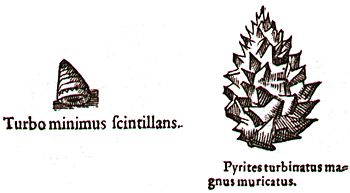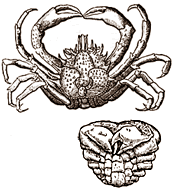

The Nature of FossilsBy the time Steno dissected the shark’s head, scholars had long debated the origins of fossils, and the debate was complicated by how 17th-century Europeans actually defined the word “fossil.” Today a fossil is understood to be evidence of ancient life preserved in rock, so its organic origin can be taken for granted. In Steno’s time, fossils could be anything dug up from the ground, including crystals or human artifacts; clearly some of these objects couldn’t be organic. Among those that were, some bore a recognizable resemblance to living organisms, such as mollusks that looked like their modern relatives. Others were harder to identify because they were poorly preserved, belonged to organisms no longer living in the region, or belonged to organisms that had become extinct. Few Renaissance or Enlightenment savants had even considered the possibility of extinction. Instead, most focused on two explanations they found more plausible: fossils had been deposited by Noah’s Flood, or fossils grew inside rocks. If one explained fossils through the Biblical Flood, shell fossils found near a shoreline didn’t stretch the limits of credulity, but fossils of marine mollusks found on mountaintops did. A flood might have deposited freshwater mollusks, but not marine mollusks. More puzzling still, how could the Earth produce, and later dispose of, enough water to cover all the mountain peaks on the globe? The natural historians of Steno’s day hoped to better understand the mind of God. This meant discerning the natural laws by which God worked, not simply assuming a miracle, but they couldn’t find a satisfactory answer. Perhaps most puzzling of all, many fossils did something no short-lived flood could make them do: they resided deep inside mountains of rock. 
In his 1598 treatise on German fossils, Jean Bauhin grouped shells and crystals together based on their overall shape. (Image from I Have Landed by Stephen Jay Gould) Given these circumstances, growth of fossils inside rocks made more sense to some people, but not to Steno. He observed that the tree roots were “twisted and compressed in countless ways in harder ground, so that they assume shapes different from those in softer ground.” If tree roots did this, fossils should too, but they didn’t. Likewise, shells growing inside rocks should crack the rocks, but they didn’t. Finally, if fossils had grown inside rocks in the past, they should continue growing in rocks in Steno’s time, but he could find no evidence of this. Even Steno’s religious convictions made him reluctant to accept this explanation. Fossils growing inside rocks had no purpose, and Steno was convinced that earthly objects were designed for specific functions. In fact, Steno was not alone in this conviction. The same conviction drove the English architect-microscopist-naturalist Robert Hooke to a similar conclusion: “Nature does nothing in vain.” Steno was among the first to realize what seems obvious today, that fossils result from once-living organisms. But understanding fossil origins was only a partial victory. It wasn’t possible to understand the progression of life on Earth without somehow relating fossils to each other in time. Scientists would outline the sequence of life on Earth centuries after Steno’s death, but in doing so, they used his principles. next: From Tuscany to the World
|

Sixteenth-century naturalist Conrad Gesner recognized the similaries between living and fossil crustaceans. (Image from The Meaning of Fossils by Martin J.S. Rudwick) | ||